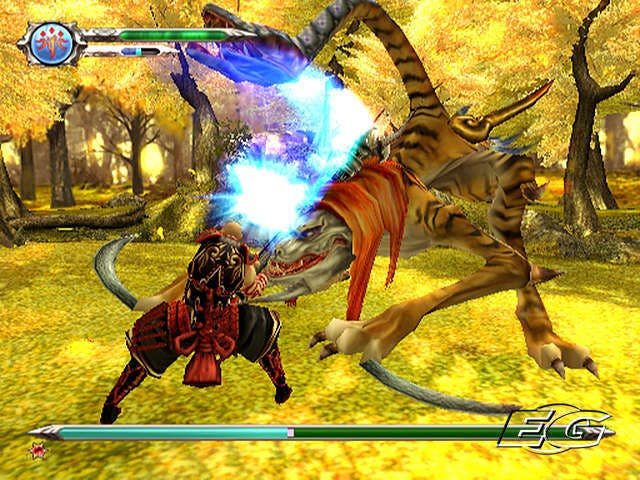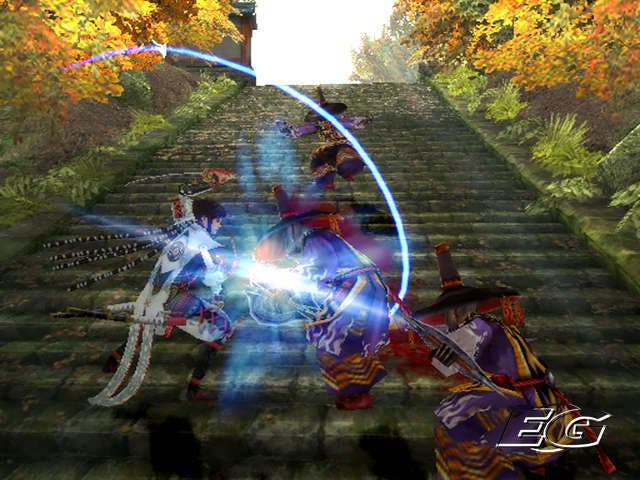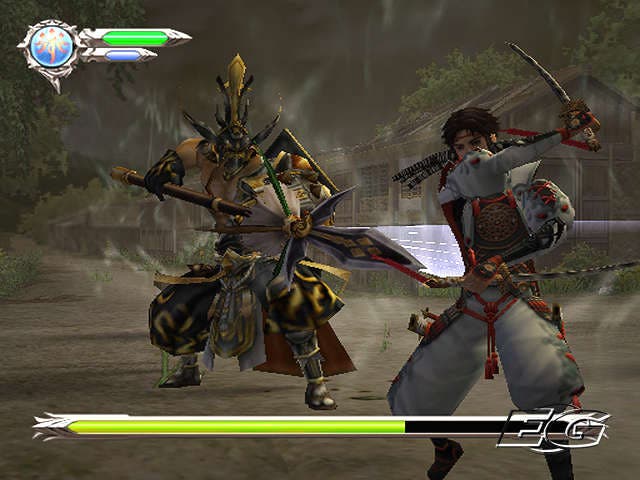Genji: Dawn of the Samurai
Terminal disappointment, Onimusha-style.
After three episodes of Onimusha, it's questionable whether the world really needed a shorter, less interesting and dumbed-down facsimile of this admirable hackandslash series. But that's precisely what Yoshiki Okamoto and his Game Republic cohorts have served up with their first post-Capcom project, Genji.
Set - once again - in ancient Japan (in this case the late 13th Century), the game centres around an incredibly simple blend of button-mashing combat and object collection, but manages to make the whole affair even more predictable and less demanding than usual. In a comically-voiced yarn that concerns the collection of the powerful Amahagane gems, it's a classic good versus evil tale: in short, the power-hungry Heishi intend on harvesting these stones to give them godlike powers, and it's up to a young warrior (Yoshitsune) and his burly monk friend (Benkei) to put a stop to their tyranny and save the land.
Essentially, collecting these Amahagane stones gives the bearer the power of Kamui, which in ancient Japanese is an excuse to insert Bullet-Time-style mechanics into an otherwise exceptionally basic button masher, where one-button attacks are the order of the day.
Short and sour

Split into three surprisingly short chapters (totalling little over six hours of gameplay on the first run through), the general theme is to control one of the two playable characters and mash your way through a series of short encounters, collecting Amahagane (mainly just scattered around the environment), powering up your weaponry and armour, and seeing off 19 spectacular but unchallenging boss creatures along the way.
Typically, every time you enter a room, the walls invisibly seal off, meaning you're forced into dispatching all the creatures within before you can continue with your travels. The fact that you can carve your way through all and sundry by perpetually stabbing (or charging up) either the square or triangle button raises alarm bells in the early stages of the game. That this farcically simplistic combat system continues to bear fruit right to the end of the game ought to give you some idea of how disappointed we were by the time we'd romped through the whole thing.
Along the way through the endless succession of drones, there's normally a door that won't open until you collect a specific item (usually a stone, oddly), and then you'll face-off against a giant triple-health-bar boss (with limited intelligence and woefully predictable attack pattern), dispatch him, collect whatever stone/power-up he's holding on to and then head back to base. This exact same formula repeats throughout the entire game, although you generally expect things to get harder and more interesting. They don't.
Condor moment

In fact, two-thirds of the way through the game, you're forced into learning the ways of the Kamui, which ought to make for a more skilful approach to combat. The idea is that you tap L1 to activate your Kamui powers; everyone in the room slows down and charges towards you, and just as they're about to strike, the square button icon flashes on the screen, allowing you to launch a devastatingly effective counter-attack and take down multiple enemies in one fell swoop.
Not only does it look incredibly cool, it's a supremely effective means of dispatching multiple enemies - not to mention taking giant chunks off of boss monster's predictably large health bars.
But - and this is the disappointing thing - there's barely any point using your Kamui powers when the regular triangle/square button mashing tactic is just as effective, if not more so. The trouble is, the Kamui attack forces you to get the timing spot on; if you don't, you end up suffering a harsh penalty and lose an equally disproportionate amount of your energy, so it's a gamble not really worth taking unless you're confident of what you're doing. The bottom line is that it's far more effective to use your regular attacks and avoid taking unnecessary risks - but doing that just reduces the gameplay into a series of uninspiring encounters that most vaguely proficient gamers will breeze through.
Even the experience system (so beautifully realised in Onimusha, and loads of games since) manages to be peculiarly uninspired. Effectively, kills gain experience, and you'll level up as you go; no big change there. But Genji favours a defence/attack rating system that's boosted by the arrival of new weapons, armour and accessories, not to mention the collection of the numerous Amahagane gems. As simple and straightforward as the whole thing is, there's no real sense of massive progression. The weapons come thick and fast, the move-set remains, and you're still, ultimately, just stabbing dementedly at the triangle and square button, and occasionally jumping beforehand. Woo hoo.
Old friends

This is a shame, naturally, as big things were expected from Game Republic. Elsewhere, the game drops plenty of hints of the talent within the developer, with some pleasant visual trickery that does a good job of portraying a rich fantasy world. Although the team has gone for a doggedly old-school static camera angle approach (why?), the backdrops are uniformly detailed - something you'd expect from a team schooled in the ways of Capcom. Lush vegetation, intricate architecture, and a myriad of incidental touches abound in a stunning and varied game environment. It counts for little, though, as it's one of those completely non-interactive experiences where you're regularly shoehorned down specific paths and can't explore beyond the set boundaries that it dictates. It does let you smash the odd pot here and there, though. How quaint.
The creatures are a bit hit and miss, too, with decent detail levels and animation, spoiled by their inability to look like they're really part of the environment. Take Benkei, for example. This lumbering monk looks like he's running in slow motion, or like the ground he's running on is a travelator working in reverse. The occasionally well-crafted boss monster saved us from the boredom of fighting an unending procession of identical goons, but even the most impressive of the lot tended to just amuse us with their abject stupidity and hilariously predictable attack patterns. It's hard to admire the wondrous animation and superb use of colour when all you have to do is run around in a circle, wait for their ponderous attack cycle to finish and whack them on the back repeatedly.
And then there's the hilarious voiceovers and forgettable script to deal with. Not content with having the most unintentionally hilarious cast of voice actors since Forbidden Siren (Benkei, in particular, is priceless), but the actual story itself is so yawnsome that all you tend to see are a stream of words on the screen, accompanied by what sounds like a bunch of six formers taking the piss out of the Japanese. Seriously.
Never again

Admittedly, the first run through does unlock a couple of new skill levels (plus the ability to play through will all the items you've gained), but the incentive to play through all over again is virtually nil. You've seen the creatures, you've cycled through the weapons, and you know what happens. You know how many other good games there are out there that would be a better way of spending your life.
Having gleaned much enjoyment from the Onimusha series, we expected a lot from Game Republic. We expected benchmark-setting visuals, a satisfying twist on the combat system, some brain-teasing puzzles and maybe a good story thrown in for good measure. The problem is, we got none of those. The visuals are - at this stage in the PS2's life cycle - quite standard now, the combat is as dumbed-down as you get in this genre, there are no puzzles to speak of whatsoever, and the story is as predictable and vacuous as you could fear.
Genji is a terminally average hackandslasher - of that, there is little doubt, and for it to come from the much-vaunted Game Republic, it's doubly disappointing. For devout fans of the genre, there's a modicum of button mashing fun to be had; but by the end of it you'll be strangely unsatisfied. As a wise man once told us, if you aim at nothing, don't be surprised if you hit it.

